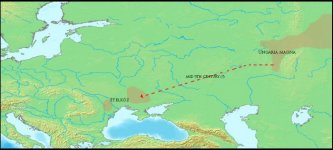I see that it is specifically B4c1b that was recently detected in Hungarian conquerors. B4c1b looks like coming from China and was surely not present near the Urals when Hungarian language developed. However, at some point it got out on the Eurasian steppe and is today also found in Pakistan and in Hazara.
Instead, mtDNA A is very old in Siberia (for example A10 in Western Siberia), but A is very old and frequent in North East Asia and America in general, so without a more specific subclade information the origin of this particular A is unclear. However, I see that there was at least 1 x A10, 1 x A11 and 2 x A12 in Hungarian conquerors. If this particular A is A10, it was probably present in Western Siberia where Ugric languages originated. However, there are other possibilities as well. Haplotype A12 seems to be shared with Mansi (other Ugric group), Yakuts (Turkic speakers) and Evenks (Tungusic speakers). The third possibility is A11. In Eurasia, A11 is today found in Bashkirs and it was also present in BA Tianshan Beilu Xinjiang. However, with all probability, the origin of Hungarian A is in northern Altai/Western Siberia.
http://biorxiv.org/content/early/2016/08/08/056655.figures-only


